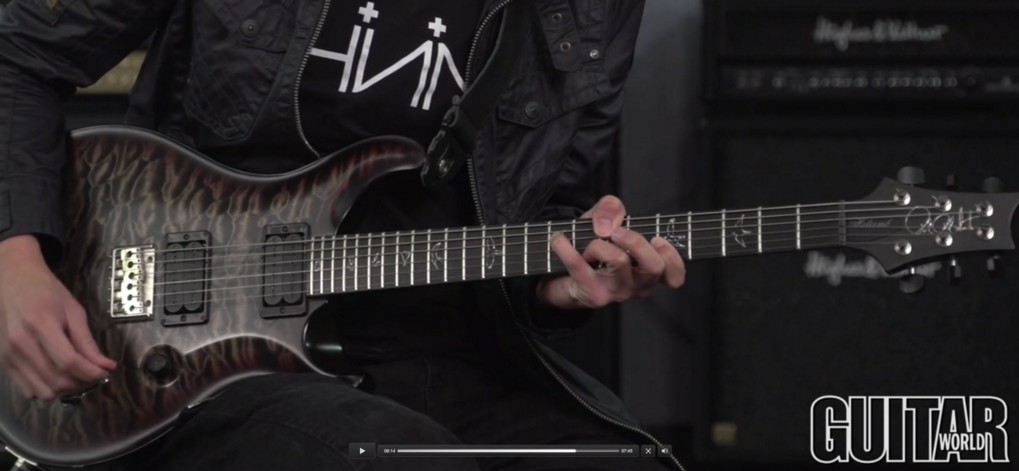Working with Five- and Six-String Chord Voicings, and How to Play Periphery's “Mile Zero”

This month’s column is a continuation of some of the concepts I first presented a few months back, which is how to craft and utilize big five- and six-string chord voicings that are harmonically complex and oftentimes equally ambiguous.
A great example of this approach in our music is the intro/verse riff to Periphery's “Mile Zero.”
Before getting into the part, let me remind you of the tuning I use for this song, which is the tuning I employ most often: drop-D, down one whole step (low to high, C G C F A D).
When playing in this tuning, I think of the guitar as being in a “transposing” tuning, meaning that I view and refer to all notes and chord names as if my guitar were tuned to drop-D standard, with the understanding that everything is going to sound a whole step lower.
FIGURE 1 represents the entire 16-bar riff, which basically alternates between very unusual Dmaj9 and Bm9 chords. Overall, this passage was an experiment to see if I could write a riff that was jagged and angular but also musically approachable, as opposed to simply sounding unsettling. The objective was to make the part interesting by way of the voicings and the specific harmonic content of the chords. You could conceivably alternate these two chord types and end up with a folk song, as opposed to a metal song, but if you “dress them up” and make them more harmonically complex, you get a completely different result.
Instead of starting with a straight D chord, I include the major seventh and ninth, with the major seventh, C#, and high D root note voiced a half step apart, and the high D root and ninth, E, voiced a whole step apart. Placing chord tones in such close proximity to one another is known as close voicing, and it yields a sound that has some friction and dissonance to it. Personally, I love the sound of these types of voicings, and this particular chord is one of my all-time favorites. I initially discovered it by simply building groups of intervals on the fretboard, placing my fret-hand fingers in different places until I found a sound that was appealing to me.
The second chord is played in ninth position, with the low B bass note fretted by wrapping the thumb over the top side of the neck. I often lean on “thumbed” low root notes for chord voicings because this technique frees up the other four fingers for fretting other, often hard-to-reach, notes. A very unusual thing about this particular voicing is that the bottom two notes are fretted with the thumb and pinkie, followed by the open fourth string and then two notes fretted with the index and middle fingers, respectively. I love the drone-y quality of the open strings in this chord, and this is another one that sounds very rich harmonically.
In essence, this is a four-bar figure played four times, but I do add little twists and alterations to keep things interesting on each repetition, such as the F#5 barre chord accent in bar 6, and the single-note melodic line in bars 8 and 9. When I first presented this riff to the band, they loved it, but, unbeknownst to me, they heard it in a completely different way, syncopation-wise, than how I intended it.
They heard the first and second chord accents as falling on beats one and two, as opposed to on the upbeats, or, in other words, an eighth note later. So we compromised and used both approaches; when the riff reappears later in the song, we play it as they had heard it, with the figures falling an eighth note later than what is illustrated here.
Holcomb-Mania February 2016 FIGURE 1

Get The Pick Newsletter
All the latest guitar news, interviews, lessons, reviews, deals and more, direct to your inbox!
